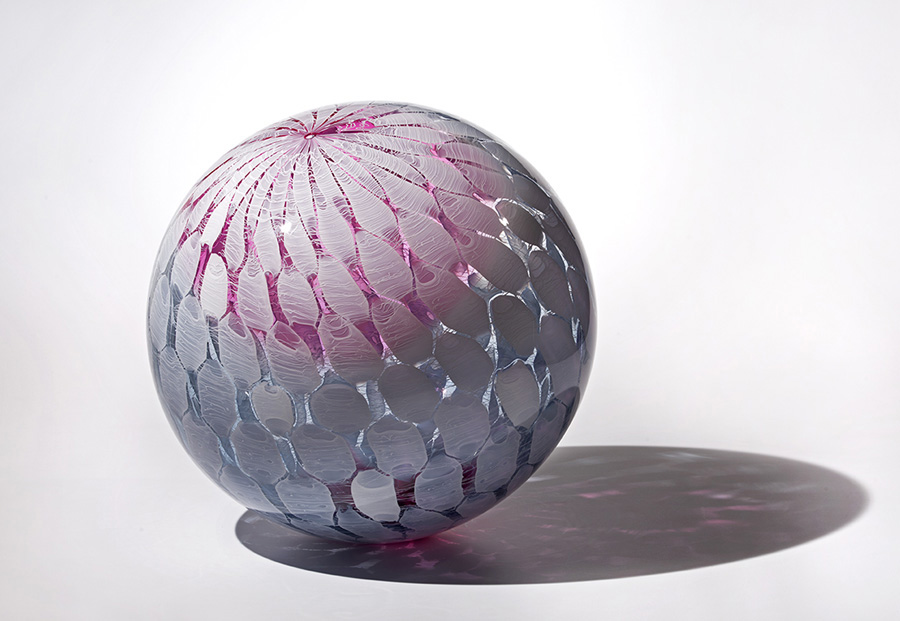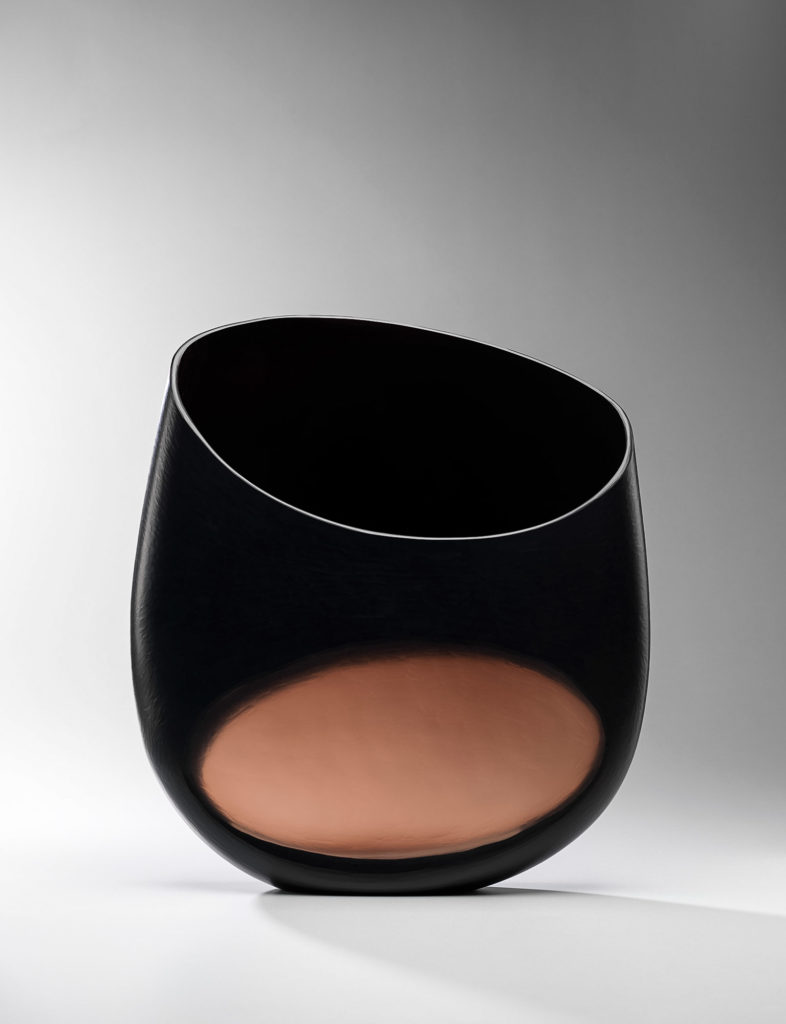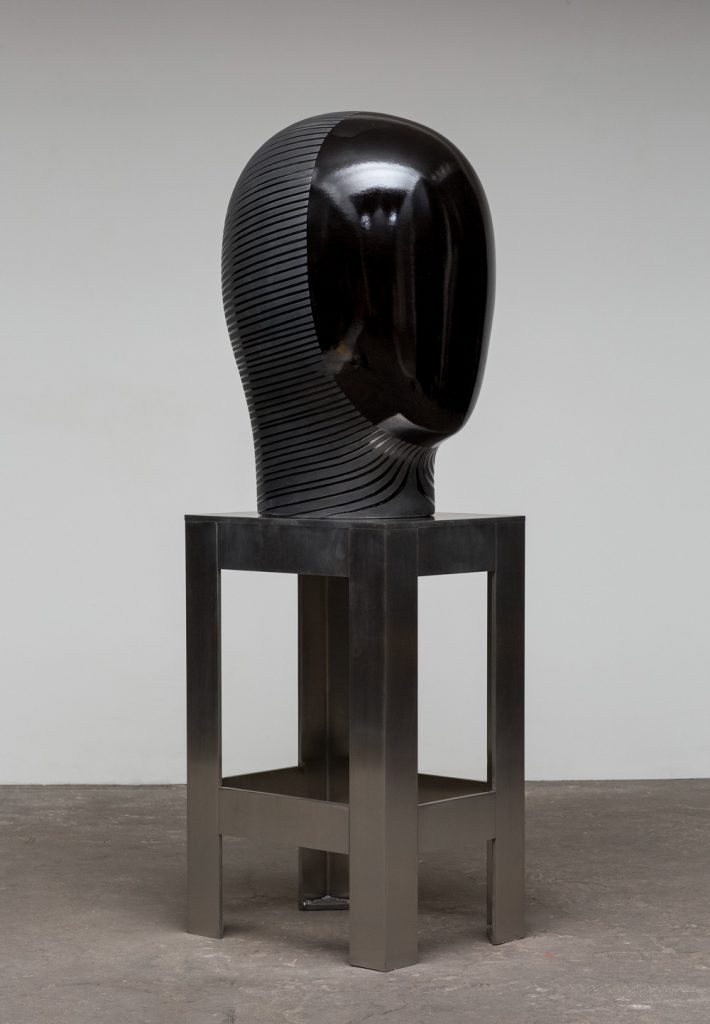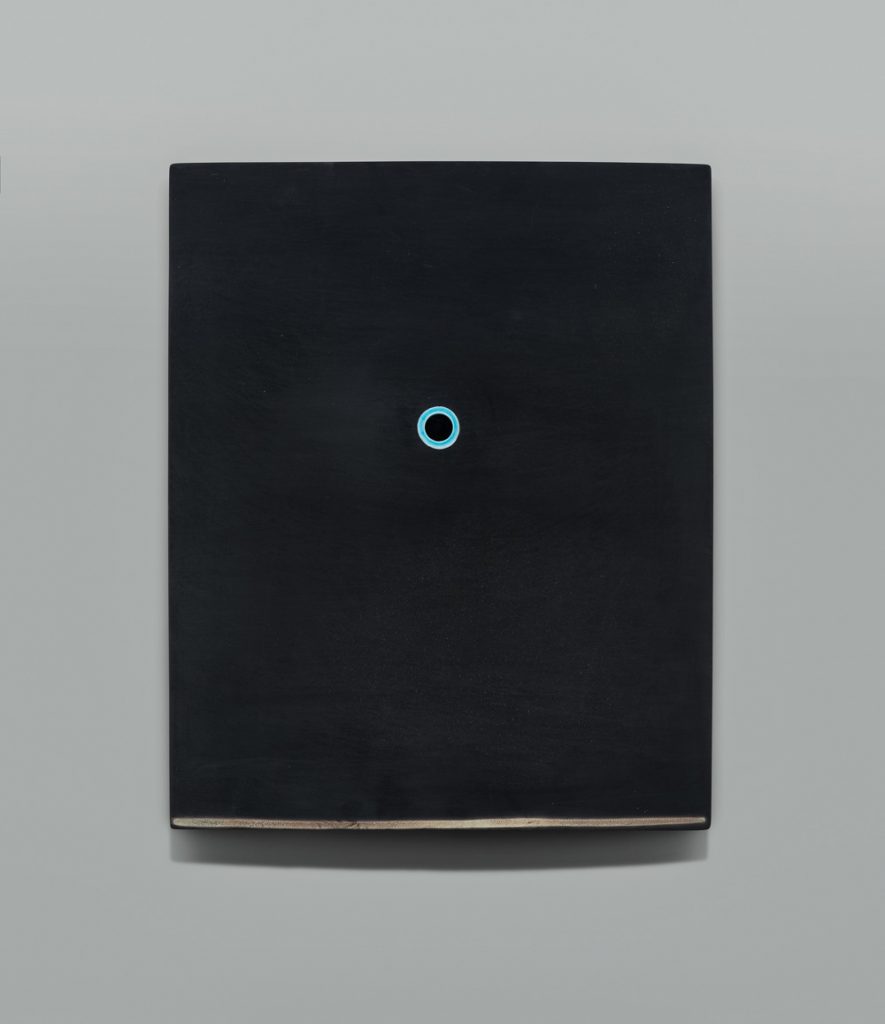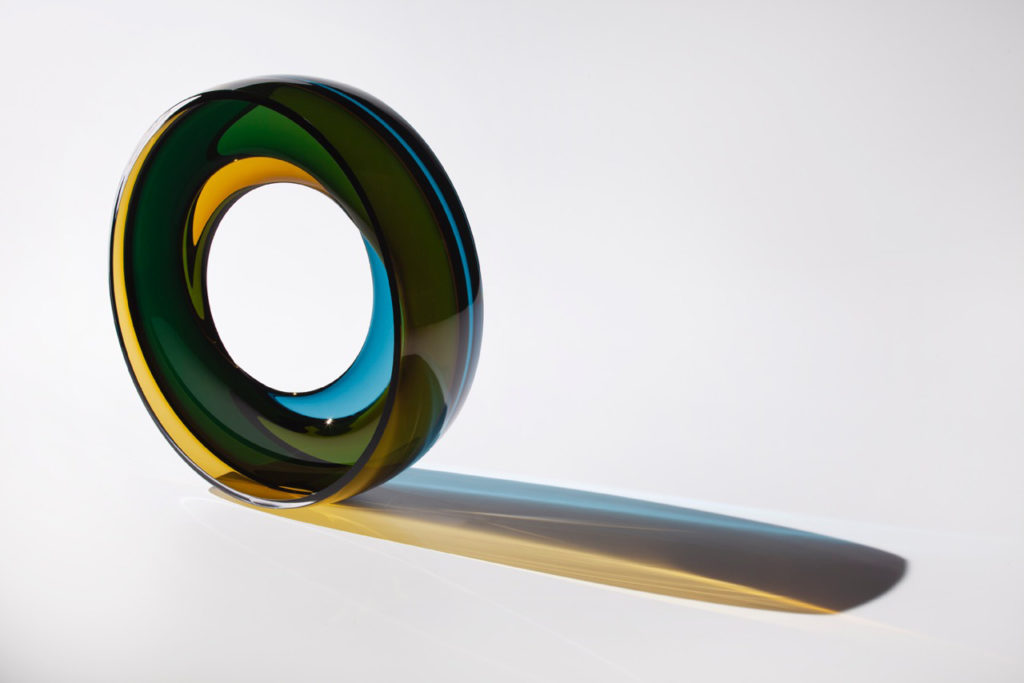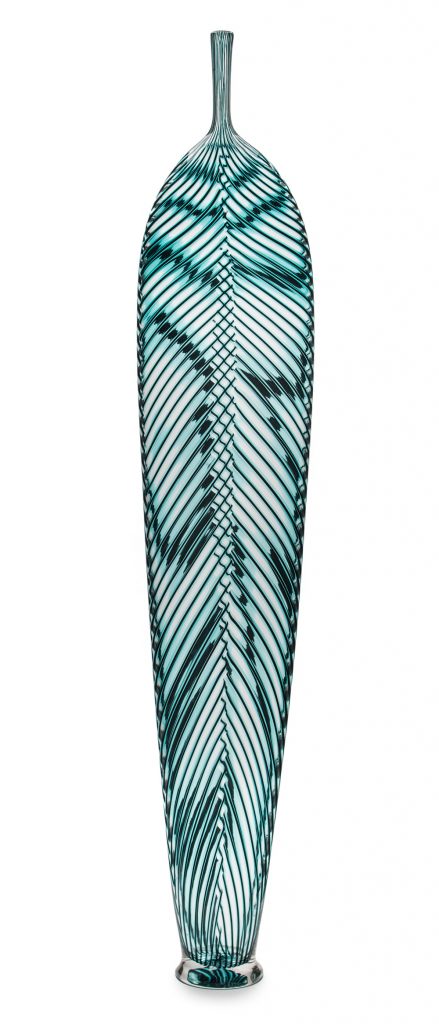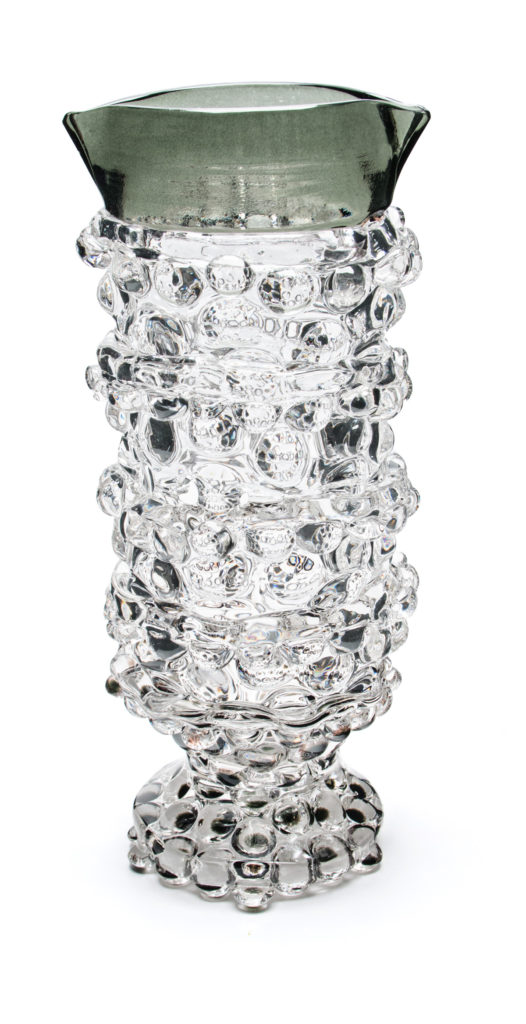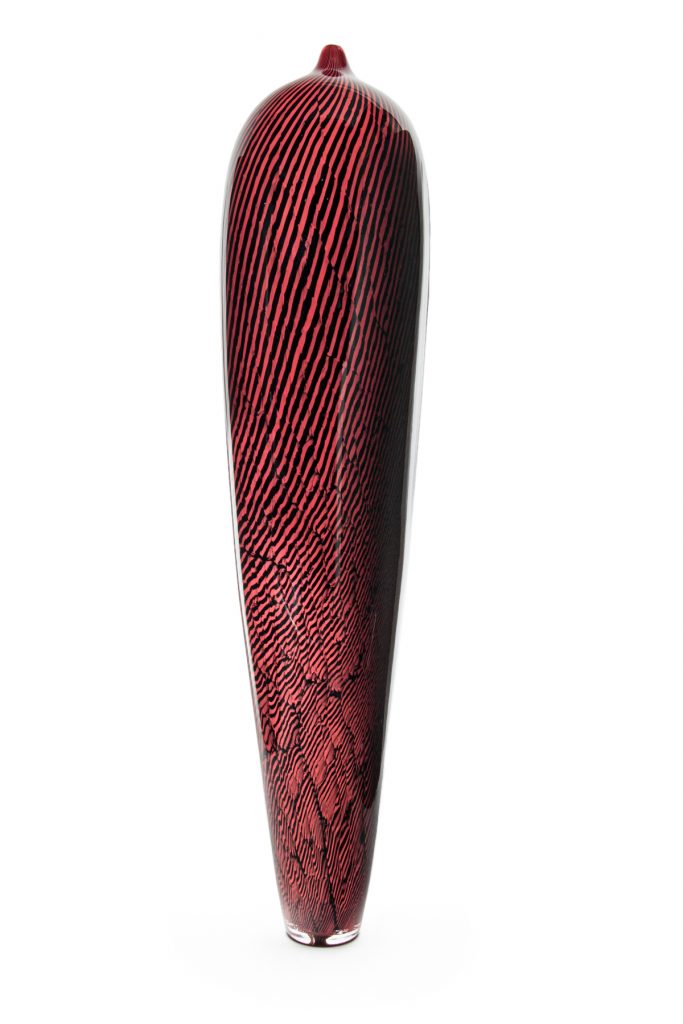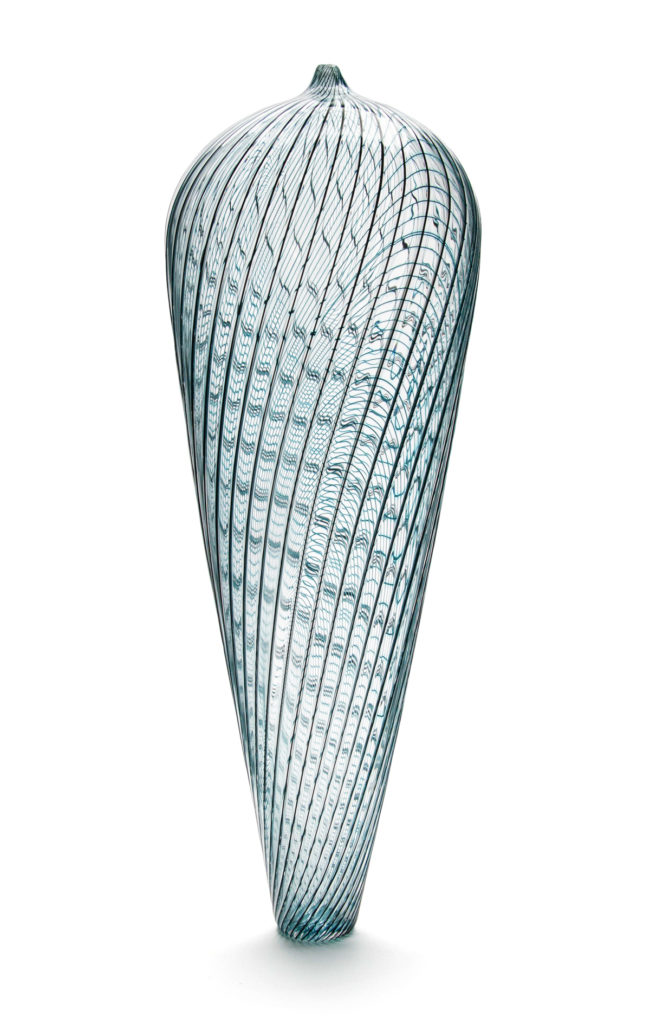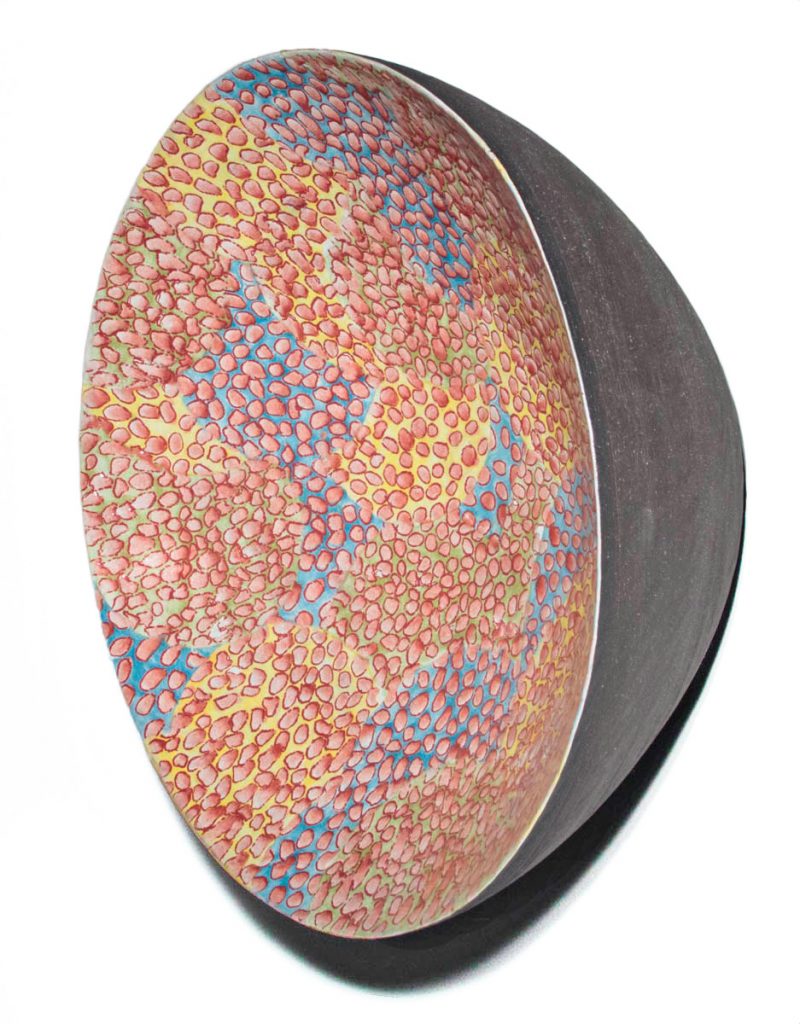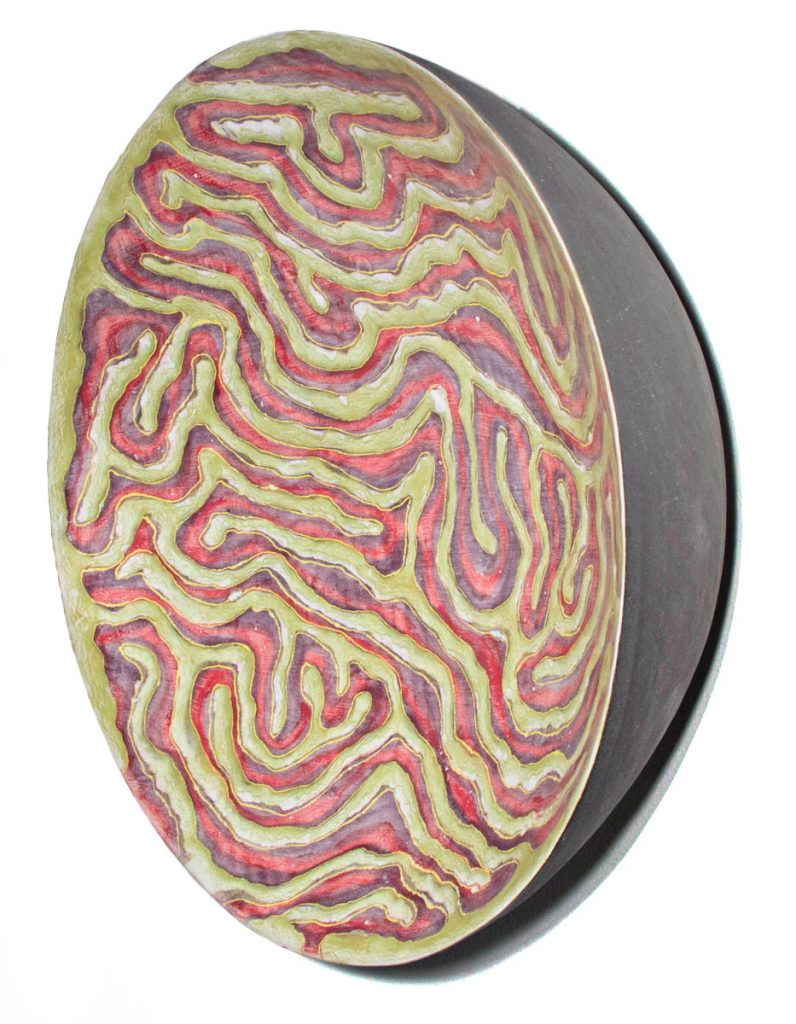Spring Exhibition
-
About
Nancy Callan - view profile
Having firmly established herself as one of the preeminent contemporary artists working in glass sculpture, Nancy Callan’s artistic voice has never been more resonant than in her forthcoming exhibition at Traver Gallery. In her new body of work, Callan celebrates and draws on her early experience as a graphic designer to bring pattern and color to the forefront. Her colorful blown forms become a beautiful canvas for the intricate overlapping, woven, organic, and playful cane and murrine designs she creates.
Building upon the techniques she mastered during her 19-year tenure on Lino Tagliapietra’s team, Callan creates cane-glass patterns that are completely her own. Like drawings in three dimensions, lines rhythmically undulate in and out of the rich glass colors. Nancy Callan’s works are exuberant, energy filled, and delightfully bold. We are proud to be the first gallery to show this new body of work and thrilled to introduce it to you, our collectors.
Nancy Callan earned her BFA from the Massachusetts College of Art in 1996. Her numerous awards include the Creative Glass Center of America Fellowship and residencies at the Museum of Glass (Tacoma, WA), The Toledo Museum of Art, Toledo, OH, the Pittsburgh Glass Center, Pittsburgh, PA, and The Chrysler Museum, Norfolk, VA. She has offered advanced glassblowing workshops at the Pilchuck Glass School in Stanwood, WA, the Pittsburgh Glass Center, Haystack Mountain School in Deer Isle, ME and Penland School of Crafts in Ashville, NC. Her work can be found in the permanent collections of the Shanghai Museum of Art, Shanghai, China, The Museum of Glass, Tacoma, WA, the Museum of Glass, Corning, NY, the Muskegon Museum of Art, Muskegon, MI, and the Museum of Northwest Art, La Connor, WA, as well as in numerous private
collections.
-
Marita Dingus
- view profile
Born in Seattle in 1956, Dingus attended Tyler School of Art at Temple University in Philadelphia (BFA, 1980) and San Jose State University (MFA, 1985). She has received a Visual Art Fellowship from Artist Trust (1994), a John S. Guggenheim Fellowship (1999), and the Morrie and Joan Alhadeff PONCHO Artist of the Year Award (2005).
Dingus has had solo shows at Henie Onstad Kunstsenter and The Stenersen Museum, both in Norway (2002, 2006), as well as the Museum of Glass in Tacoma, WA (2005 – 2006). Her work has been included in Nature/Culture organized by The Society for Contemporary Craft in Pittsburgh (2006 – 2008), Outwin Boochever Portrait Competition at the National Portrait Gallery in Washington, DC (2006 – 2007) and 21st Century American Women Artists at the Residence of the United States Ambassador to NATO in Brussels, Belgium (2006 – 2010). Her work is in many regional museums and corporate collections. Dingus currently lives and works in the state of Washington and is represented by Traver Gallery in Seattle.
“I consider myself an African-American Feminist and environmental artist. My approach to producing art is environmentally and politically infused: neither waste humanity nor the gifts of nature. I am primarily a mixed media sculptor who uses discarded materials. My art draws upon relics from the African Diaspora. The discarded materials represent how people of African descent were used during the institution of slavery and colonialism then discarded, but who found ways to repurpose themselves and thrive in a hostile world. I seek to use recovered materials, reconfiguring and incorporating them into pieces of art where possible and appropriate, and to mitigate waste and pollution in all my work. This is a creative challenge, but a commitment I incorporate into my professional and personal activities.”
-
Tim Edwards
- view profile
Tim came to glass from a ceramic background, from which he developed a bold sense of design and surface manipulation. This can be seen in the works for which he has gained an international reputation. Tim’s work is blown or shaped in the hotshop and then cut, carved and ground using the lathe with diamond and stone wheels.
He has a strong connection to JamFactory, the premier Craft and Design facility located in Adelaide, South Australia. He first completed a traineeship in Ceramics in 1992 with Stephen Bowers and then went on to complete a traineeship in Glass with Nick Mount, both experiences have played a significant role in his development. Tim also worked as an artist at Blue Pony studio from 2001 to 2008.He now works as an artist and glass studio technician at JamFactory, and shares a home studio with partner, Clare Belfrage.
Tim has spent time in North America as a teacher and student at the Pilchuck Glass School, Haystack School of Crafts and at Ohio State University as a Scholar in Residence. In 2007 he undertook a residency at the Tacoma Museum of Glass as a visiting artist.
Exhibiting nationally and internationally, Tim has art work in major public collections, notably the Corning Museum of Glass, Corning, USA, Museum of Glass, Tacoma, USA, National Gallery of Australia, Art Gallery of South Australia, National Gallery of Victoria, Art Gallery of Western Australia and Wagga Wagga National Art Glass collection. In 2006 Tim was awarded the Rakow Commission from the Corning Museum of Glass, being the second Australian to receive this significant award.
In 2018 Tim was selected as one of 30 artists to participate in the prestigious Adelaide Biennial of Australian Art, “Divided Worlds” at the Art Gallery of South Australia.
-
Jun Kaneko
- view profile
Jun Kaneko was born in Nagoya, Japan in 1942. He studied painting with Satoshi Ogawa during his adolescence – working in his studio during the day and attending high school in the evening. He came to the United States in 1963 to continue his studies at Chouinard Institute of Art when his introduction to Fred Marer drew him to sculptural ceramics. He proceeded to study with Peter Voulkos, Paul Soldner, and Jerry Rothman in California during the time now defined as The Contemporary Ceramics Movement in America. The following decade, Kaneko taught at some of the nation’s leading art schools, including Scripps College, Rhode Island School of Design and Cranbrook Academy of Art.
Based in Omaha since 1986, Jun Kaneko has worked at several experimental studios including European Ceramic Work Center in The Netherlands, Otsuka Omi Ceramic Company in Japan, Fabric Workshop in Philadelphia PA, Bullseye Glass in Portland OR, Acadia Summer Arts Program in Bar Harbor ME, and Aguacate in Puerto Vallarta, Mexico. Over the course of his career, he has partnered with industrial facilities to realize large-scale, hand-built sculptures. The first was his 1982-1983 Omaha Project at Omaha Brickworks. Later sculptures include his Fremont Project, completed in 1992-1994 in California, and most recently his Pittsburg Project completed in 2004-2007 in Kansas. Both of these later series of sculptures were created at Mission Clay Products. In April 2013, his exhibition Myths, Legends and Truths opened at Millennium Park in Chicago featuring thirteen nine-and-a-half foot tall Dangos and twenty-three of his Tanukis. This new body of work by Kaneko draws upon the myths and legends of the tanuki figure.
His artwork appears in numerous international and national solo and group exhibitions annually and is included in more than seventy museum collections. He has realized over thirty public art commissions in the United States and Japan and is the recipient of national, state and organization fellowships. Kaneko holds honorary doctorates from the University of Nebraska, the Massachusetts College of Art & Design and the Royal College of Art in London.
Kaneko is increasingly drawn to installations that promote civic interaction. He has completed over fifty public art commissions, including his two three hundred and fifty foot long Tile Walls at Aquarium Station in Boston, MA (1993-2000), a 3-story high wall in the Biology Library at The University of Connecticut (1997) and at the the Mashima Sports Arena in Osaka Japan (1994); permanent plaza installations in Council Bluffs and Des Moines, IA (2007 and 2013), at Bartle Hall and Convention Center in Kansas City, KS (2006), and at the International Finance Center in Shanghai, China (2012). In 2014 his fifty-six foot tall Glass Tower, Plaza Design, and Tile Wall will be permanently installed in Lincoln, NE.
Jun Kaneko’s new design for San Francisco Opera’s production of Mozart’s The Magic Flute is currently touring the United States. It opened in San Francisco, Omaha, Kansas City. Its final performance will take place at The Washington National Opera at The John F. Kennedy Center. His production of Puccini’s Madame Butterfly, which premiered at Opera Omaha in March 2006, opened in June 2014 at the San Francisco Opera.
In 1998, he and his wife Ree Kaneko formed a non-profit cultural organization in Omaha Nebraska called KANEKO that explores and encourages the process of creativity. KANEKO is headquartered in landmark, turn-of-the-century warehouses in the Old Market District of Omaha, Nebraska. Jun Kaneko continues his dedication to life as an artist and as a cultural catalyst for the region.
-
John Kiley
- view profile
American, b. 1973, Seattle, USA, based in Seattle and San Francisco, USA.
John Kiley, a renowned artist at the forefront of contemporary glass sculpture, is known for his groundbreaking exploration at the intersection of sculpture, blown glass, and architectural forms. With a unique blend of technical expertise and artistic vision, Kiley’s work transcends boundaries with a dynamic interplay of light, structure, and spatial relationships.
Kiley’s affinity for glass was evident from an early age. As a teenager, he experimented with painting on glass. Later, he refined his skills through formal training and apprenticeships with master artists, including 16 years with Lino Tagliapietra, developing a deep understanding of traditional glassblowing and fabrication techniques.
Kiley’s sculptures frequently incorporate individual elements into larger frameworks, showcasing his meticulous attention to detail and risk-taking approach. Whether creating towering structures, intricate blown glass orbs, or delicately assembled shattered blocks, each series exemplifies his ability to seemingly defy gravity. Through this creative process, he explores the inherent tension between chaos and order, strength and fragility, resulting in works that evoke metamorphosis and the intrinsic beauty of imperfection.
In addition to his solo work, Kiley is known for his collaborative projects with architects, engineers, and other master artists, pushing the boundaries of what is possible within the realm of glass in sculpture. His willingness to experiment with scale, materials, and techniques have earned him widespread acclaim and recognition, with his work featured in galleries, museums, and public spaces worldwide.
-
Dante Marioni
- view profile
Dante Marioni burst onto the international glass scene at the age of 19 with a signature style that has been described as the purest of classical forms executed in glass by an American glassblower. His amphoras, vases, and ewers are derived from Greek and Etruscan prototypes, yet they are imaginatively and sometimes whimsically reinterpreted. His impossibly elongated, sinuous shapes are made with bright and saturated contrasting colors.
Marioni’s sophisticated glass objects evoke the rich tradition of classical Mediterranean pottery and bronzes, and of Marioni’s training in centuries-old Venetian glassblowing techniques with some of the greatest masters in contemporary glass.
The son of American studio glass pioneer Paul Marioni, Dante was raised in a family of artists that includes two well-known uncles, painter Joseph Marioni and conceptual artist Tom Marioni.
Marioni first held a blowpipe at the age of nine. By the time he was 15, he was working after school at one of the first cooperative hotshops and showrooms, The Glass Eye, in Seattle Washington. Although he loved glassblowing, making production studio glass felt limiting.
“The prevailing aesthetic [in American studio glass in the 1970s] was loose and free-form” observed Marioni, “I personally had no interest in that.” Around the same time he met up with Benjamin Moore, another studio glass pioneer, and watched Moore make a perfectly symmetrical, on-center glass form inspired by Venetian glass. It had a dramatic and lasting effect on Marioni, who had not previously seen this type of glassblowing.
Moore soon became a great mentor and friend. “I worked with Benny any chance I got and still use his studio to this day to make some of my really large pieces,” Marioni says. He also studied with other well-known studio glass pioneers, such as Fritz Dreisbach and Richard Marquis, who is widely recognized for his unique interpretations of Venetian decorative techniques.
In 1983, Moore introduced Marioni to Lino Tagliapietra, the legendary maestro who traveled from Murano to teach young American glassblowers at the Pilchuck Glass School in Washington state. “I took classes with Lino throughout the 1990s, and because of him, I received a very classical education in glassblowing. I never missed an opportunity to be around him.”
At the age of 23, Dante Marioni had his first sell-out gallery show in Seattle that featured his Whopper vases. This series introduced his signature, monumental forms and two-color style, and earned him a prestigious Louis Comfort Tiffany Fellowship. After two decades of experimentation, Marioni now creates a diverse range of tall, iconic forms with surface treatments such as murrine (mosaic) and reticello (air bubbles within a net pattern) in an ever-changing array of vibrant colors.
His most recent works are sculptural vessels inspired by the leaf. “Not the leaf in nature, but the stylized forms found in the decorative arts,” Marioni notes. The new vessels are beguilingly intricate, inventive, fresh and tradition-breaking. While his earlier work was about “form, conceived and executed from a design point of view,” his newest works focus on the exploration of color and pattern.
For Dante Marioni, making objects is about the art of glassblowing rather than the creation of glass art, the process rather than the result. Marioni’s elegant works are the brilliant record of his on-going relationship with and exploration of this material.
-
Charlie Parriott
- view profile
Charlie Parriott is an American born glass artist and consultant living and working in Seattle, Washington and Prague, Czech Republic. Parriott has been working with glass in commercial and artistic application since 1972. He is one of the few Americans to have studied with and later taught with Czech sculptor and pedagogue, Stanislav Libensky, in the 1980s. In 2001, after a 12-year stint as colorist and consultant tor the Chihuly Studio, Parriott moved to direct construction and program development of the hot glass studio for the Museum of Glass, Tacoma, Washington. Parriott set the Guinness Book world record for producing the world’s largest bottle of wine in 2004. Currently, Charlie pursues his own artistic career while continuing to fabricate challenging works for other artists and companies. He is a Fulbright Scholar and recipient of the National Endowment for the Arts Fellowship.
For his most recent body of work, featured in the Traver Gallery exhibition Old Friends, New Work, Charlie worked with master engraver Pavlina Čambalová, to realize his designs. Recognized internationally for her accomplishments as an engraver, Čambalová has been the recipient of several awards including the Main Award for glass engraving from the Symposium of Schools of Applied Arts, the Moser Company Award, the Commendation of the Jury of the Internationaler Glaskunstpreis der Stadt Rheinbach in 2007; and a 2012 award from Craft and Art in Glass in the engraved glass category. Click here to watch a video by Material Times about Pavlina Čambalová engraving process.
-
Therman Statom
- view profile
Therman Statom – sculptor, glass artist, and painter – is most notably known as a pioneer of the contemporary glass movement for his life-size glass ladders, chairs, tables, constructed box-like paintings, and small scale houses; all created through the technique of gluing glass plate together. Sandblasted surfaces become a canvas for spontaneous vibrant colors and line work, which take nuances from Abstract Expressionism and concepts of Minimalism, while simultaneously incorporating a twist by using blown-glass elements and found objects.
Born in Winter Haven, Florida in 1953, Statom spent his adolescence growing up in Washington, D.C. His interest in the arts grew from a fondness of painting and he began to investigate ceramics at RISD. However, after an experimental glass blowing session with Dale Chihuly, he was soon hooked on the spontaneity of glass blowing and its limitless possibilities. Statom went on to pursue studies at Pilchuck Glass School during its inaugural year, completing a BFA in 1974 from RISD, and later studied at the Pratt Institute of Art & Design.
Throughout his career, public artworks have been permanently installed at prominent locations including the Los Angeles Public Library, Corning, Inc. Headquarters, the Mayo Clinic, San Jose Ice Center, the Toledo Museum of Art, and the Jepson Center for the Arts in the Telfair Museum, Savannah as well as several hospitals across the country.
His artwork appears in numerous exhibitions annually, including solo and group shows around the nation and internationally. Over the span of his career, he has completed over thirty large, site- specific installations. Most notably in recent years, his 2009 solo exhibition “Stories of the New World,” at the Orlando Museum of Art, which spanned over 5,000 square feet, has been his largest installation to date. Exploring themes related to Juan Ponce de Leon’s 1513 search for the fabled Fountain of Youth as a point of departure, the installation referenced historic and contemporary themes of hope, discovery, ambition, and destiny. Visitors traversed the gallery space consisting of a mirrored maze, panoramic glass wall mural, a room-size structure built entirely of glass, and video projections. In conjunction with the exhibit, Statom partnered with the educational department of the OMA and the Zora Neale Hurston National Museum of Eatonville to work with over eighty young students to create a work of art titled, “Glass House”, which was a large, walk-though structure built from glass boxes designed by the children. The piece was later displayed at the annual summer community festival.
Much of the latter half of Statom’s career has been focused on the importance of educational programming within the arts. He has taken a deep interested in employing workshops as a catalyst for social change and in affect, positively impacting a community. Working directly with the artist himself, adults and children alike share a combined experience of exploring art making via a hands-on experience. Inhibitions and limitations are left by the wayside, and the practice or act of “doing” becomes a journey of self-discovery, creating an opportunity for the participant to go to a new place within themselves.
“I believe art can be understood both conceptually and intuitively. I think there is a need for the general public to come to an understanding that to appreciate art and creativity they must trust his or her self; that extensive education is not a prerequisite for understanding art. Much of what I do is seeded in what is more of an intuitive process; a large portion of my work is exploring these processes within people and their environments.
The fact is, I believe that creativity is a part of all aspects of what people do; my studio and educational efforts via workshops and the support of outside programming, general educational and cultural institutions, are a reflection of this belief.
I feel that art is tool for empowerment and education. It’s also a viable tool to investigate positive change and engage a culture through the use of exploration.”
-
Lino Tagliapietra
- view profile
Lino Tagliapietra was born on Murano, a Venetian island which has served as the world’s glass capital for the past millennium. At the age of twelve, the artist apprenticed with Archimede Seguso. Training for glassblowers on Murano is traditionally structured, rigorous and slow; yet, within this system, Tagliapietra was a prodigy. After nine years of assisting, he achieved the title of maestro. Subsequently, he worked at several of Murano’s greatest factories: Galliano Ferro, Venini, Effetre International, and La Murrina (which he founded).
A significant shift in the Studio Glass Movement began in 1979 when Tagliapietra accepted Benjamin Moore’s invitation to teach at Pilchuck Glass School. There, he established many enduring professional contacts and continuing relationships with students. The importance of his teaching to the development of glass as an artistic medium cannot be overstated.
Tagliapietra was the recipient of the prestigious Rakow Commission granted in 1996 by the Corning Museum of Glass, The Glass Art Society Lifetime Achievement Award, and the 2004 Visionary Award from the Museum of Arts & Design in New York. His work has been exhibited throughout Europe, Asia, and North America and is included in numerous prominent public collections including The Metropolitan Museum of Art in New York, New York; The Corning Museum of Glass in Corning, New York; The Danish Royal Museum in Copenhagen, Denmark; The Jewish Museum in San Francisco, California; Musée des Arts Décoratifs in Paris, France, and Museo del Vidrio in Monterrey, Mexico.
-
Kathy Venter
- view profile
Kathy’s life-size, figurative ceramic sculpture has received international acclaim.
She has developed a unique hand building method to sculpt these ceramics without the use of molds or armatures. Venter’s exhibition Life was represented at a solo exhibition at the Gardiner Museum, Toronto in the summer of 2013, and Bellevue Art Museum, Seattle, WA., in the spring of 2014. CIRCA, Johannesburg December 2014/January 2015. IMA museum, WA. August – December 2015. Venter participated in exhibitions at the Bellevue Arts Museum in Seattle and California State University, Sacramento in 2010. Her work has been shown in over 23 solo exhibitions and 50 group exhibitions, since her immigration to Canada in 1989.
Amongst others, Venter’s work is in the collections of: Gardiner Museum of Contemporary Ceramics, Toronto, South African National Gallery, Pretoria, Ceramics Museum Cesky Krumlov, Czech Republic, Permanent Collection, Port Elizabeth School of Art and Design, Gates Foundation, Seattle, Richard B. Sachs Collection, New York and John Le Febvre collection Salt Spring Island.
-
Jamie Walker
- view profile
Jamie Walker is a professor at the University of Washington where he holds the Wyckoff Milliman Endowed Chair of Art and was appointed Director of the School of Art + Art History + Design in 2014. He was the recipient of the University’s Distinguished Teaching Award in 2008. Walker studied at the University of Washington where he received a BA/History and a BFA/Ceramics before receiving his MFA at the Rhode Island School of Design. His work has been featured in 24 one-person exhibitions and numerous group exhibitions throughout the U.S. and Europe. Collections include the Seattle Art Museum, Henry Art Gallery, Racine Art Museum, International Museum of Glass, and the Museo del Vino, Torgiano Italy. Reviews of his work have appeared in Ceramics: Art and Perception, Sculpture, New Art Examiner, Ceramics Monthly and American Ceramics. In 2005 he was honored with a Flintridge Foundation Artist Grant and in 2010 completed a three-piece outdoor commission for Vulcan Inc., located at the Amazon headquarters in Seattle.
“My recent studio work has been directed by materiality, perception and chance and has included participatory installations, wall bowls and spherical accumulations rendered at both an intimate or large scale. I am intrigued by the plethora of ever shifting information, both real and imagined, that can be observed from watching clouds, viewing cellular structures, studying landscape paintings or taking a walk on the beach. I am interested in the metaphorical potential of exploiting the somewhat uncontrollable nature of the ceramic process with the conscious and technical control I try to exert with the glazed surfaces. These sources serve as gateways to my studio endeavors where I create work that eventually becomes stationary and permanent, but may still allow for an imaginative, even meditative, perceptual experience.”
